Marketing Plan for Aldi: Strategy and Application
VerifiedAdded on 2023/05/31
|14
|4487
|464
AI Summary
This marketing plan outlines the strengths, weaknesses, opportunities, and threats of Aldi, a leading retailer with over 8,000 stores worldwide. It discusses Aldi's pricing strategy, product mix, and advertising efforts, as well as its objectives and strategies for growth.
Contribute Materials
Your contribution can guide someone’s learning journey. Share your
documents today.
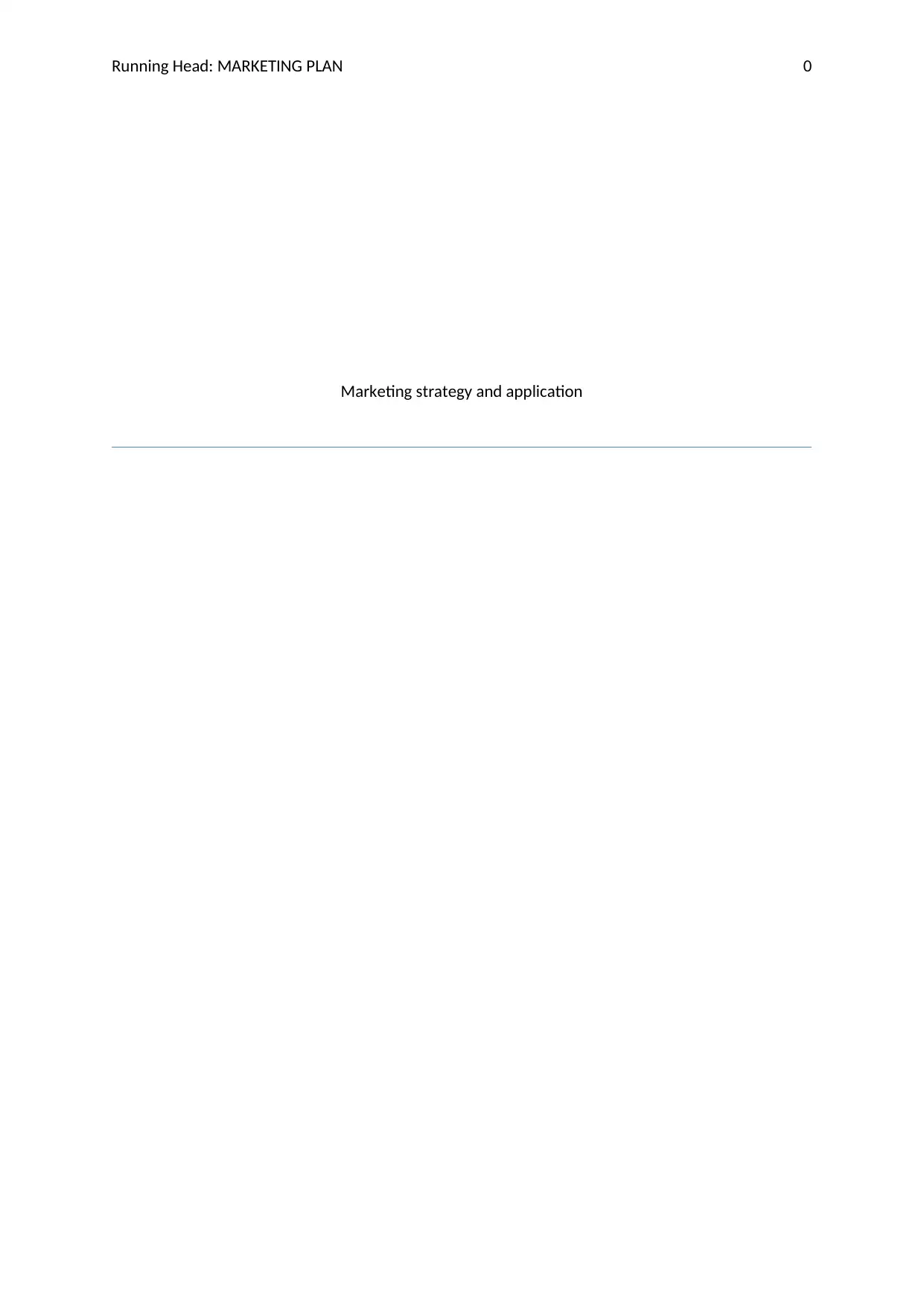
Running Head: MARKETING PLAN 0
Marketing strategy and application
Marketing strategy and application
Secure Best Marks with AI Grader
Need help grading? Try our AI Grader for instant feedback on your assignments.
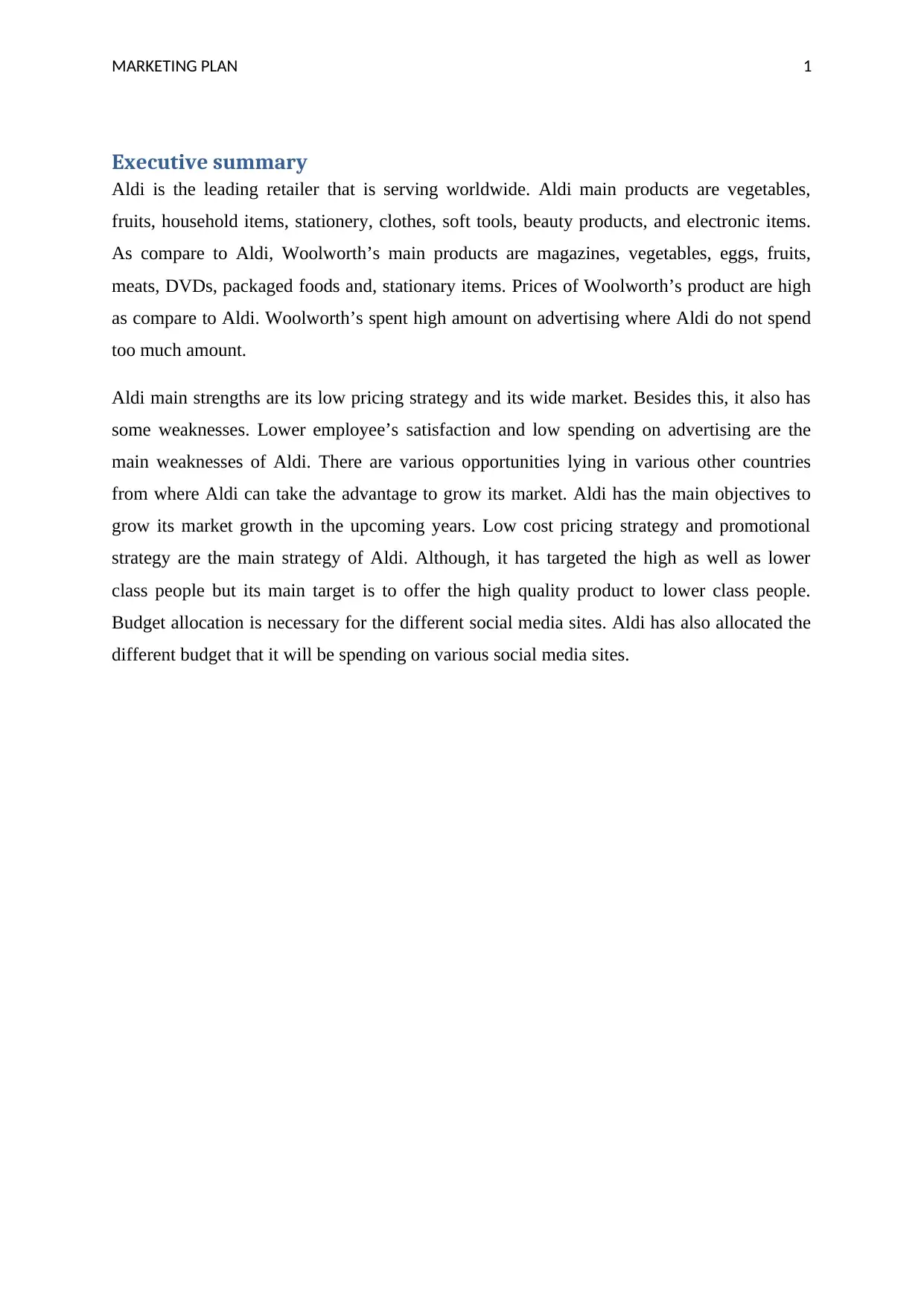
MARKETING PLAN 1
Executive summary
Aldi is the leading retailer that is serving worldwide. Aldi main products are vegetables,
fruits, household items, stationery, clothes, soft tools, beauty products, and electronic items.
As compare to Aldi, Woolworth’s main products are magazines, vegetables, eggs, fruits,
meats, DVDs, packaged foods and, stationary items. Prices of Woolworth’s product are high
as compare to Aldi. Woolworth’s spent high amount on advertising where Aldi do not spend
too much amount.
Aldi main strengths are its low pricing strategy and its wide market. Besides this, it also has
some weaknesses. Lower employee’s satisfaction and low spending on advertising are the
main weaknesses of Aldi. There are various opportunities lying in various other countries
from where Aldi can take the advantage to grow its market. Aldi has the main objectives to
grow its market growth in the upcoming years. Low cost pricing strategy and promotional
strategy are the main strategy of Aldi. Although, it has targeted the high as well as lower
class people but its main target is to offer the high quality product to lower class people.
Budget allocation is necessary for the different social media sites. Aldi has also allocated the
different budget that it will be spending on various social media sites.
Executive summary
Aldi is the leading retailer that is serving worldwide. Aldi main products are vegetables,
fruits, household items, stationery, clothes, soft tools, beauty products, and electronic items.
As compare to Aldi, Woolworth’s main products are magazines, vegetables, eggs, fruits,
meats, DVDs, packaged foods and, stationary items. Prices of Woolworth’s product are high
as compare to Aldi. Woolworth’s spent high amount on advertising where Aldi do not spend
too much amount.
Aldi main strengths are its low pricing strategy and its wide market. Besides this, it also has
some weaknesses. Lower employee’s satisfaction and low spending on advertising are the
main weaknesses of Aldi. There are various opportunities lying in various other countries
from where Aldi can take the advantage to grow its market. Aldi has the main objectives to
grow its market growth in the upcoming years. Low cost pricing strategy and promotional
strategy are the main strategy of Aldi. Although, it has targeted the high as well as lower
class people but its main target is to offer the high quality product to lower class people.
Budget allocation is necessary for the different social media sites. Aldi has also allocated the
different budget that it will be spending on various social media sites.
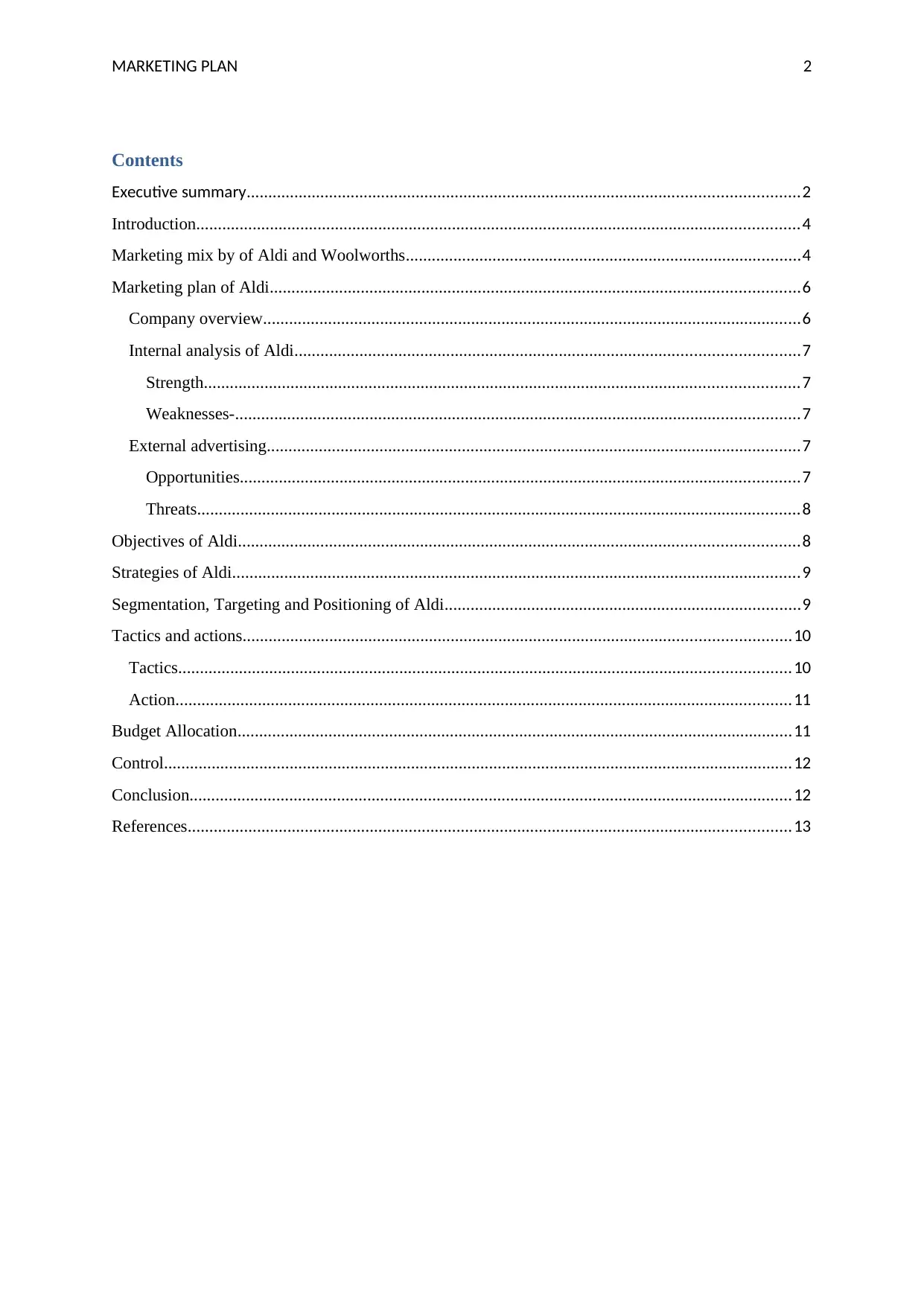
MARKETING PLAN 2
Contents
Executive summary...............................................................................................................................2
Introduction...........................................................................................................................................4
Marketing mix by of Aldi and Woolworths...........................................................................................4
Marketing plan of Aldi..........................................................................................................................6
Company overview............................................................................................................................6
Internal analysis of Aldi....................................................................................................................7
Strength.........................................................................................................................................7
Weaknesses-..................................................................................................................................7
External advertising...........................................................................................................................7
Opportunities.................................................................................................................................7
Threats...........................................................................................................................................8
Objectives of Aldi.................................................................................................................................8
Strategies of Aldi...................................................................................................................................9
Segmentation, Targeting and Positioning of Aldi..................................................................................9
Tactics and actions..............................................................................................................................10
Tactics.............................................................................................................................................10
Action..............................................................................................................................................11
Budget Allocation................................................................................................................................11
Control.................................................................................................................................................12
Conclusion...........................................................................................................................................12
References...........................................................................................................................................13
Contents
Executive summary...............................................................................................................................2
Introduction...........................................................................................................................................4
Marketing mix by of Aldi and Woolworths...........................................................................................4
Marketing plan of Aldi..........................................................................................................................6
Company overview............................................................................................................................6
Internal analysis of Aldi....................................................................................................................7
Strength.........................................................................................................................................7
Weaknesses-..................................................................................................................................7
External advertising...........................................................................................................................7
Opportunities.................................................................................................................................7
Threats...........................................................................................................................................8
Objectives of Aldi.................................................................................................................................8
Strategies of Aldi...................................................................................................................................9
Segmentation, Targeting and Positioning of Aldi..................................................................................9
Tactics and actions..............................................................................................................................10
Tactics.............................................................................................................................................10
Action..............................................................................................................................................11
Budget Allocation................................................................................................................................11
Control.................................................................................................................................................12
Conclusion...........................................................................................................................................12
References...........................................................................................................................................13
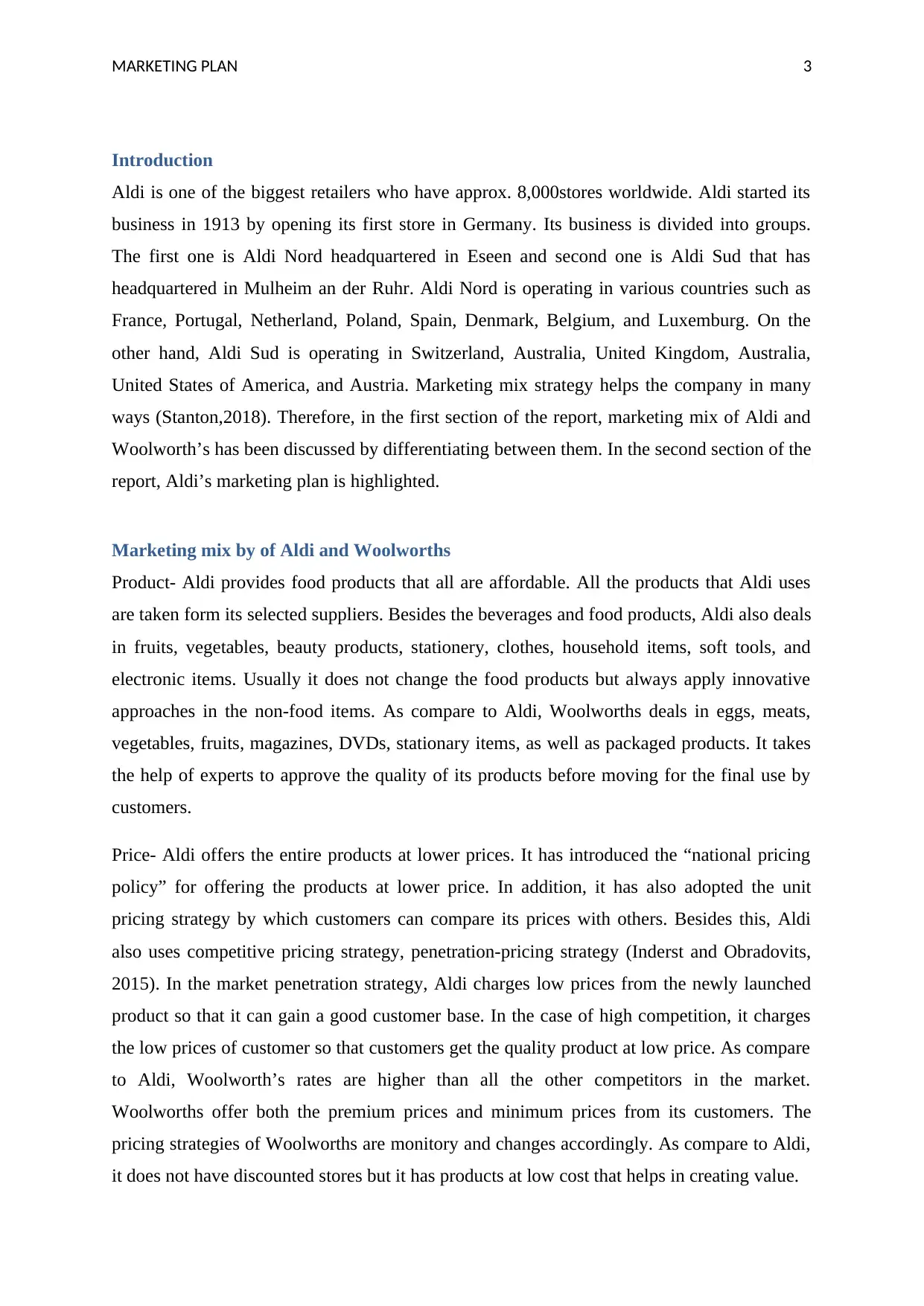
MARKETING PLAN 3
Introduction
Aldi is one of the biggest retailers who have approx. 8,000stores worldwide. Aldi started its
business in 1913 by opening its first store in Germany. Its business is divided into groups.
The first one is Aldi Nord headquartered in Eseen and second one is Aldi Sud that has
headquartered in Mulheim an der Ruhr. Aldi Nord is operating in various countries such as
France, Portugal, Netherland, Poland, Spain, Denmark, Belgium, and Luxemburg. On the
other hand, Aldi Sud is operating in Switzerland, Australia, United Kingdom, Australia,
United States of America, and Austria. Marketing mix strategy helps the company in many
ways (Stanton,2018). Therefore, in the first section of the report, marketing mix of Aldi and
Woolworth’s has been discussed by differentiating between them. In the second section of the
report, Aldi’s marketing plan is highlighted.
Marketing mix by of Aldi and Woolworths
Product- Aldi provides food products that all are affordable. All the products that Aldi uses
are taken form its selected suppliers. Besides the beverages and food products, Aldi also deals
in fruits, vegetables, beauty products, stationery, clothes, household items, soft tools, and
electronic items. Usually it does not change the food products but always apply innovative
approaches in the non-food items. As compare to Aldi, Woolworths deals in eggs, meats,
vegetables, fruits, magazines, DVDs, stationary items, as well as packaged products. It takes
the help of experts to approve the quality of its products before moving for the final use by
customers.
Price- Aldi offers the entire products at lower prices. It has introduced the “national pricing
policy” for offering the products at lower price. In addition, it has also adopted the unit
pricing strategy by which customers can compare its prices with others. Besides this, Aldi
also uses competitive pricing strategy, penetration-pricing strategy (Inderst and Obradovits,
2015). In the market penetration strategy, Aldi charges low prices from the newly launched
product so that it can gain a good customer base. In the case of high competition, it charges
the low prices of customer so that customers get the quality product at low price. As compare
to Aldi, Woolworth’s rates are higher than all the other competitors in the market.
Woolworths offer both the premium prices and minimum prices from its customers. The
pricing strategies of Woolworths are monitory and changes accordingly. As compare to Aldi,
it does not have discounted stores but it has products at low cost that helps in creating value.
Introduction
Aldi is one of the biggest retailers who have approx. 8,000stores worldwide. Aldi started its
business in 1913 by opening its first store in Germany. Its business is divided into groups.
The first one is Aldi Nord headquartered in Eseen and second one is Aldi Sud that has
headquartered in Mulheim an der Ruhr. Aldi Nord is operating in various countries such as
France, Portugal, Netherland, Poland, Spain, Denmark, Belgium, and Luxemburg. On the
other hand, Aldi Sud is operating in Switzerland, Australia, United Kingdom, Australia,
United States of America, and Austria. Marketing mix strategy helps the company in many
ways (Stanton,2018). Therefore, in the first section of the report, marketing mix of Aldi and
Woolworth’s has been discussed by differentiating between them. In the second section of the
report, Aldi’s marketing plan is highlighted.
Marketing mix by of Aldi and Woolworths
Product- Aldi provides food products that all are affordable. All the products that Aldi uses
are taken form its selected suppliers. Besides the beverages and food products, Aldi also deals
in fruits, vegetables, beauty products, stationery, clothes, household items, soft tools, and
electronic items. Usually it does not change the food products but always apply innovative
approaches in the non-food items. As compare to Aldi, Woolworths deals in eggs, meats,
vegetables, fruits, magazines, DVDs, stationary items, as well as packaged products. It takes
the help of experts to approve the quality of its products before moving for the final use by
customers.
Price- Aldi offers the entire products at lower prices. It has introduced the “national pricing
policy” for offering the products at lower price. In addition, it has also adopted the unit
pricing strategy by which customers can compare its prices with others. Besides this, Aldi
also uses competitive pricing strategy, penetration-pricing strategy (Inderst and Obradovits,
2015). In the market penetration strategy, Aldi charges low prices from the newly launched
product so that it can gain a good customer base. In the case of high competition, it charges
the low prices of customer so that customers get the quality product at low price. As compare
to Aldi, Woolworth’s rates are higher than all the other competitors in the market.
Woolworths offer both the premium prices and minimum prices from its customers. The
pricing strategies of Woolworths are monitory and changes accordingly. As compare to Aldi,
it does not have discounted stores but it has products at low cost that helps in creating value.
Secure Best Marks with AI Grader
Need help grading? Try our AI Grader for instant feedback on your assignments.
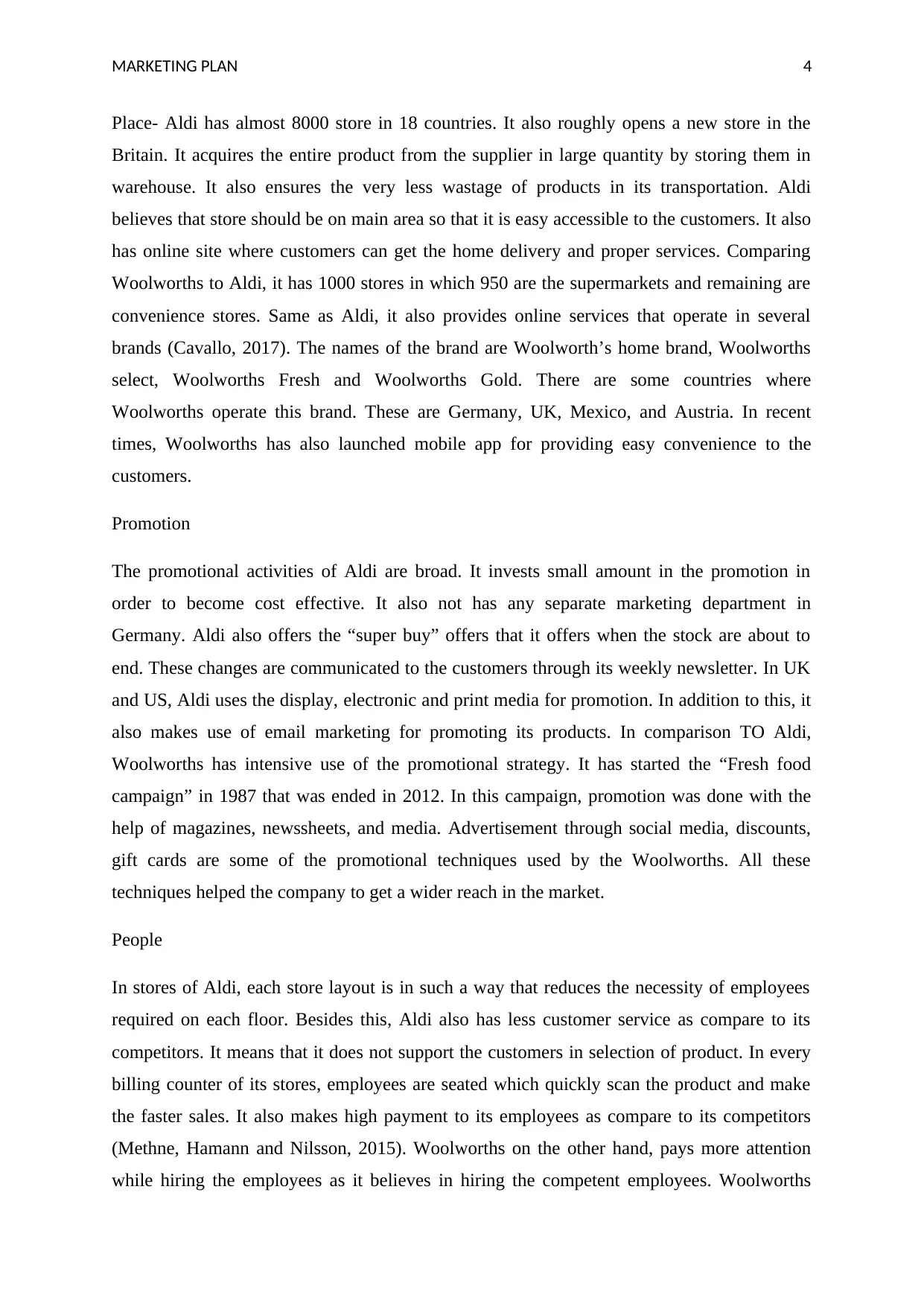
MARKETING PLAN 4
Place- Aldi has almost 8000 store in 18 countries. It also roughly opens a new store in the
Britain. It acquires the entire product from the supplier in large quantity by storing them in
warehouse. It also ensures the very less wastage of products in its transportation. Aldi
believes that store should be on main area so that it is easy accessible to the customers. It also
has online site where customers can get the home delivery and proper services. Comparing
Woolworths to Aldi, it has 1000 stores in which 950 are the supermarkets and remaining are
convenience stores. Same as Aldi, it also provides online services that operate in several
brands (Cavallo, 2017). The names of the brand are Woolworth’s home brand, Woolworths
select, Woolworths Fresh and Woolworths Gold. There are some countries where
Woolworths operate this brand. These are Germany, UK, Mexico, and Austria. In recent
times, Woolworths has also launched mobile app for providing easy convenience to the
customers.
Promotion
The promotional activities of Aldi are broad. It invests small amount in the promotion in
order to become cost effective. It also not has any separate marketing department in
Germany. Aldi also offers the “super buy” offers that it offers when the stock are about to
end. These changes are communicated to the customers through its weekly newsletter. In UK
and US, Aldi uses the display, electronic and print media for promotion. In addition to this, it
also makes use of email marketing for promoting its products. In comparison TO Aldi,
Woolworths has intensive use of the promotional strategy. It has started the “Fresh food
campaign” in 1987 that was ended in 2012. In this campaign, promotion was done with the
help of magazines, newssheets, and media. Advertisement through social media, discounts,
gift cards are some of the promotional techniques used by the Woolworths. All these
techniques helped the company to get a wider reach in the market.
People
In stores of Aldi, each store layout is in such a way that reduces the necessity of employees
required on each floor. Besides this, Aldi also has less customer service as compare to its
competitors. It means that it does not support the customers in selection of product. In every
billing counter of its stores, employees are seated which quickly scan the product and make
the faster sales. It also makes high payment to its employees as compare to its competitors
(Methne, Hamann and Nilsson, 2015). Woolworths on the other hand, pays more attention
while hiring the employees as it believes in hiring the competent employees. Woolworths
Place- Aldi has almost 8000 store in 18 countries. It also roughly opens a new store in the
Britain. It acquires the entire product from the supplier in large quantity by storing them in
warehouse. It also ensures the very less wastage of products in its transportation. Aldi
believes that store should be on main area so that it is easy accessible to the customers. It also
has online site where customers can get the home delivery and proper services. Comparing
Woolworths to Aldi, it has 1000 stores in which 950 are the supermarkets and remaining are
convenience stores. Same as Aldi, it also provides online services that operate in several
brands (Cavallo, 2017). The names of the brand are Woolworth’s home brand, Woolworths
select, Woolworths Fresh and Woolworths Gold. There are some countries where
Woolworths operate this brand. These are Germany, UK, Mexico, and Austria. In recent
times, Woolworths has also launched mobile app for providing easy convenience to the
customers.
Promotion
The promotional activities of Aldi are broad. It invests small amount in the promotion in
order to become cost effective. It also not has any separate marketing department in
Germany. Aldi also offers the “super buy” offers that it offers when the stock are about to
end. These changes are communicated to the customers through its weekly newsletter. In UK
and US, Aldi uses the display, electronic and print media for promotion. In addition to this, it
also makes use of email marketing for promoting its products. In comparison TO Aldi,
Woolworths has intensive use of the promotional strategy. It has started the “Fresh food
campaign” in 1987 that was ended in 2012. In this campaign, promotion was done with the
help of magazines, newssheets, and media. Advertisement through social media, discounts,
gift cards are some of the promotional techniques used by the Woolworths. All these
techniques helped the company to get a wider reach in the market.
People
In stores of Aldi, each store layout is in such a way that reduces the necessity of employees
required on each floor. Besides this, Aldi also has less customer service as compare to its
competitors. It means that it does not support the customers in selection of product. In every
billing counter of its stores, employees are seated which quickly scan the product and make
the faster sales. It also makes high payment to its employees as compare to its competitors
(Methne, Hamann and Nilsson, 2015). Woolworths on the other hand, pays more attention
while hiring the employees as it believes in hiring the competent employees. Woolworths
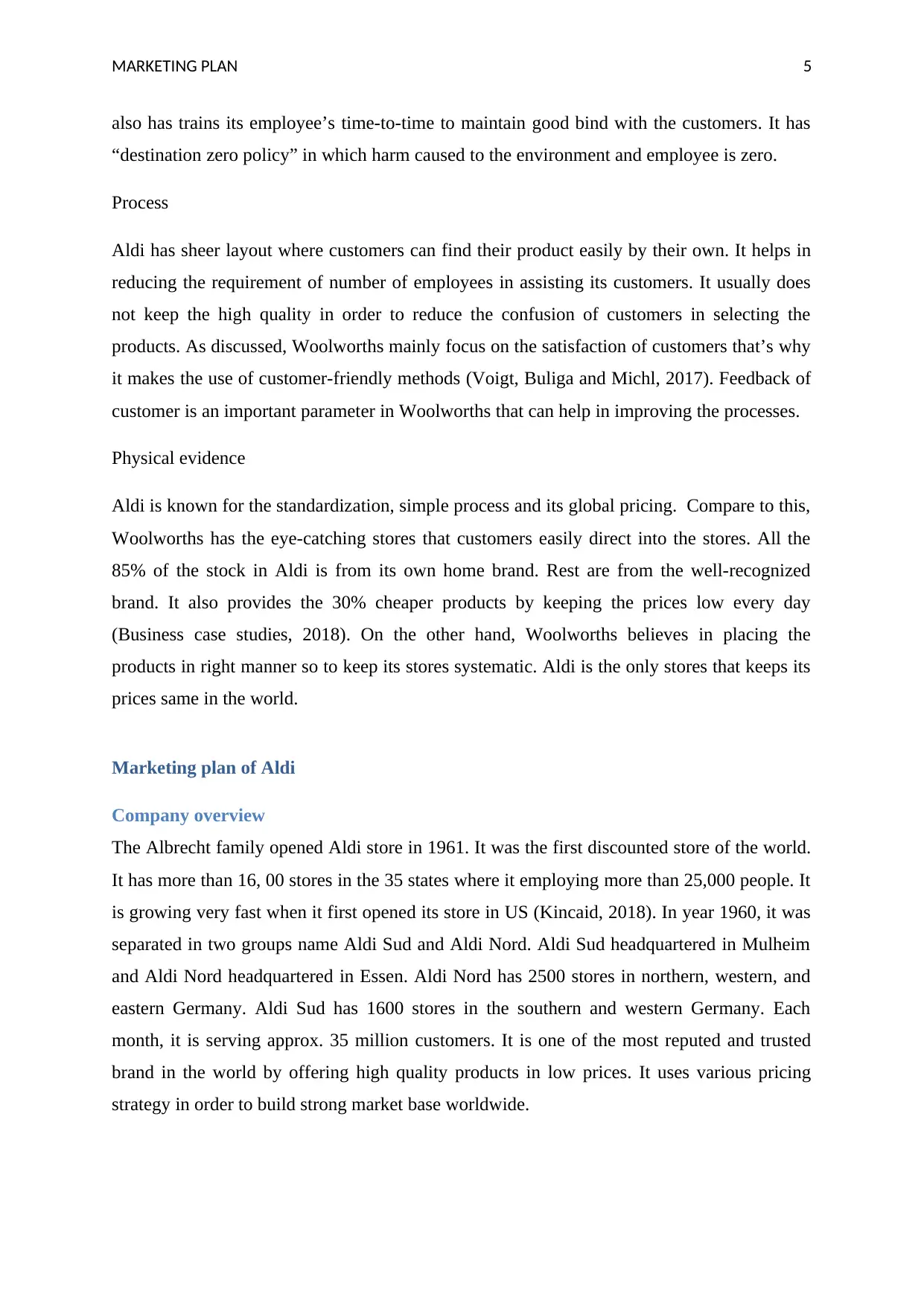
MARKETING PLAN 5
also has trains its employee’s time-to-time to maintain good bind with the customers. It has
“destination zero policy” in which harm caused to the environment and employee is zero.
Process
Aldi has sheer layout where customers can find their product easily by their own. It helps in
reducing the requirement of number of employees in assisting its customers. It usually does
not keep the high quality in order to reduce the confusion of customers in selecting the
products. As discussed, Woolworths mainly focus on the satisfaction of customers that’s why
it makes the use of customer-friendly methods (Voigt, Buliga and Michl, 2017). Feedback of
customer is an important parameter in Woolworths that can help in improving the processes.
Physical evidence
Aldi is known for the standardization, simple process and its global pricing. Compare to this,
Woolworths has the eye-catching stores that customers easily direct into the stores. All the
85% of the stock in Aldi is from its own home brand. Rest are from the well-recognized
brand. It also provides the 30% cheaper products by keeping the prices low every day
(Business case studies, 2018). On the other hand, Woolworths believes in placing the
products in right manner so to keep its stores systematic. Aldi is the only stores that keeps its
prices same in the world.
Marketing plan of Aldi
Company overview
The Albrecht family opened Aldi store in 1961. It was the first discounted store of the world.
It has more than 16, 00 stores in the 35 states where it employing more than 25,000 people. It
is growing very fast when it first opened its store in US (Kincaid, 2018). In year 1960, it was
separated in two groups name Aldi Sud and Aldi Nord. Aldi Sud headquartered in Mulheim
and Aldi Nord headquartered in Essen. Aldi Nord has 2500 stores in northern, western, and
eastern Germany. Aldi Sud has 1600 stores in the southern and western Germany. Each
month, it is serving approx. 35 million customers. It is one of the most reputed and trusted
brand in the world by offering high quality products in low prices. It uses various pricing
strategy in order to build strong market base worldwide.
also has trains its employee’s time-to-time to maintain good bind with the customers. It has
“destination zero policy” in which harm caused to the environment and employee is zero.
Process
Aldi has sheer layout where customers can find their product easily by their own. It helps in
reducing the requirement of number of employees in assisting its customers. It usually does
not keep the high quality in order to reduce the confusion of customers in selecting the
products. As discussed, Woolworths mainly focus on the satisfaction of customers that’s why
it makes the use of customer-friendly methods (Voigt, Buliga and Michl, 2017). Feedback of
customer is an important parameter in Woolworths that can help in improving the processes.
Physical evidence
Aldi is known for the standardization, simple process and its global pricing. Compare to this,
Woolworths has the eye-catching stores that customers easily direct into the stores. All the
85% of the stock in Aldi is from its own home brand. Rest are from the well-recognized
brand. It also provides the 30% cheaper products by keeping the prices low every day
(Business case studies, 2018). On the other hand, Woolworths believes in placing the
products in right manner so to keep its stores systematic. Aldi is the only stores that keeps its
prices same in the world.
Marketing plan of Aldi
Company overview
The Albrecht family opened Aldi store in 1961. It was the first discounted store of the world.
It has more than 16, 00 stores in the 35 states where it employing more than 25,000 people. It
is growing very fast when it first opened its store in US (Kincaid, 2018). In year 1960, it was
separated in two groups name Aldi Sud and Aldi Nord. Aldi Sud headquartered in Mulheim
and Aldi Nord headquartered in Essen. Aldi Nord has 2500 stores in northern, western, and
eastern Germany. Aldi Sud has 1600 stores in the southern and western Germany. Each
month, it is serving approx. 35 million customers. It is one of the most reputed and trusted
brand in the world by offering high quality products in low prices. It uses various pricing
strategy in order to build strong market base worldwide.
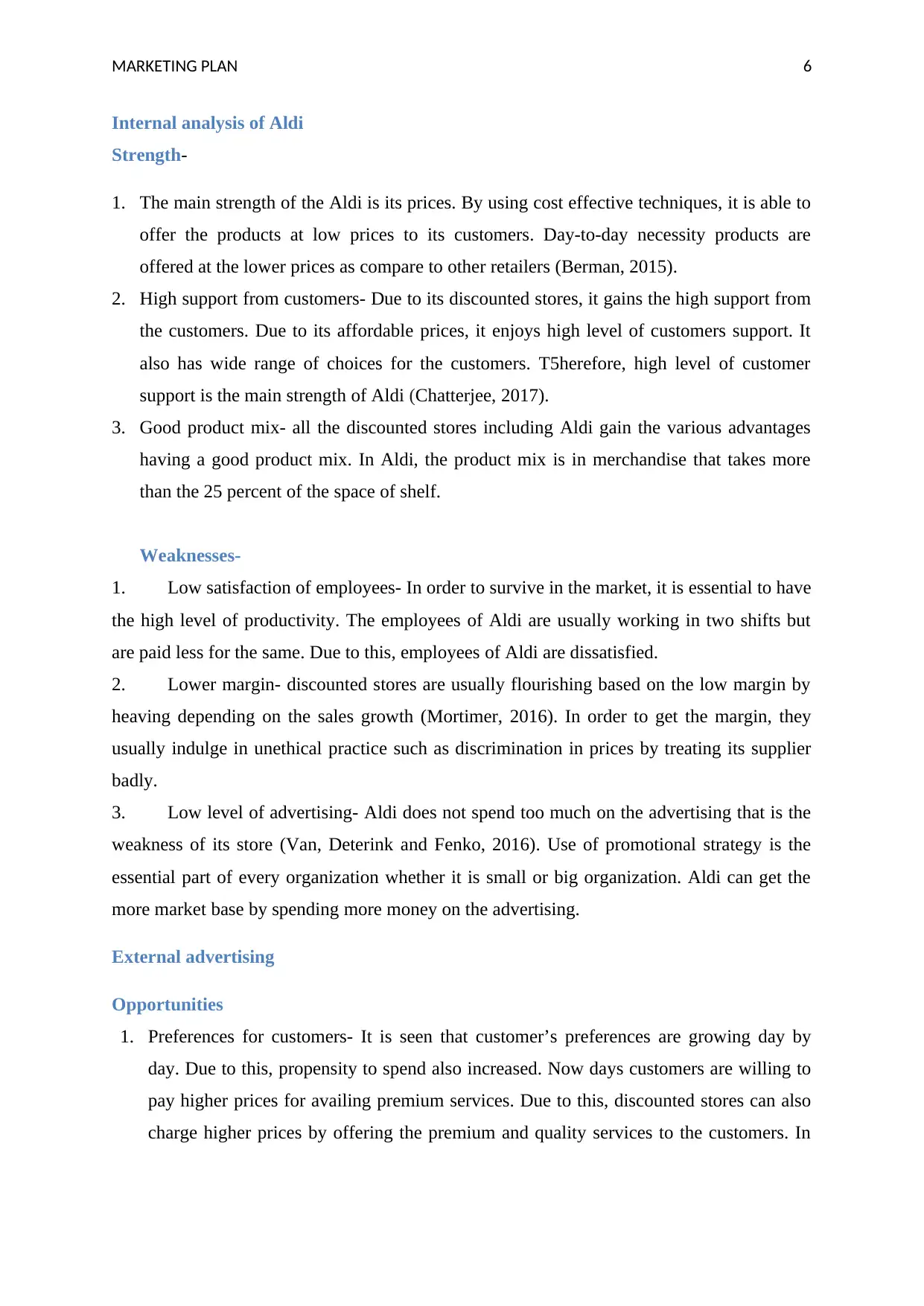
MARKETING PLAN 6
Internal analysis of Aldi
Strength-
1. The main strength of the Aldi is its prices. By using cost effective techniques, it is able to
offer the products at low prices to its customers. Day-to-day necessity products are
offered at the lower prices as compare to other retailers (Berman, 2015).
2. High support from customers- Due to its discounted stores, it gains the high support from
the customers. Due to its affordable prices, it enjoys high level of customers support. It
also has wide range of choices for the customers. T5herefore, high level of customer
support is the main strength of Aldi (Chatterjee, 2017).
3. Good product mix- all the discounted stores including Aldi gain the various advantages
having a good product mix. In Aldi, the product mix is in merchandise that takes more
than the 25 percent of the space of shelf.
Weaknesses-
1. Low satisfaction of employees- In order to survive in the market, it is essential to have
the high level of productivity. The employees of Aldi are usually working in two shifts but
are paid less for the same. Due to this, employees of Aldi are dissatisfied.
2. Lower margin- discounted stores are usually flourishing based on the low margin by
heaving depending on the sales growth (Mortimer, 2016). In order to get the margin, they
usually indulge in unethical practice such as discrimination in prices by treating its supplier
badly.
3. Low level of advertising- Aldi does not spend too much on the advertising that is the
weakness of its store (Van, Deterink and Fenko, 2016). Use of promotional strategy is the
essential part of every organization whether it is small or big organization. Aldi can get the
more market base by spending more money on the advertising.
External advertising
Opportunities
1. Preferences for customers- It is seen that customer’s preferences are growing day by
day. Due to this, propensity to spend also increased. Now days customers are willing to
pay higher prices for availing premium services. Due to this, discounted stores can also
charge higher prices by offering the premium and quality services to the customers. In
Internal analysis of Aldi
Strength-
1. The main strength of the Aldi is its prices. By using cost effective techniques, it is able to
offer the products at low prices to its customers. Day-to-day necessity products are
offered at the lower prices as compare to other retailers (Berman, 2015).
2. High support from customers- Due to its discounted stores, it gains the high support from
the customers. Due to its affordable prices, it enjoys high level of customers support. It
also has wide range of choices for the customers. T5herefore, high level of customer
support is the main strength of Aldi (Chatterjee, 2017).
3. Good product mix- all the discounted stores including Aldi gain the various advantages
having a good product mix. In Aldi, the product mix is in merchandise that takes more
than the 25 percent of the space of shelf.
Weaknesses-
1. Low satisfaction of employees- In order to survive in the market, it is essential to have
the high level of productivity. The employees of Aldi are usually working in two shifts but
are paid less for the same. Due to this, employees of Aldi are dissatisfied.
2. Lower margin- discounted stores are usually flourishing based on the low margin by
heaving depending on the sales growth (Mortimer, 2016). In order to get the margin, they
usually indulge in unethical practice such as discrimination in prices by treating its supplier
badly.
3. Low level of advertising- Aldi does not spend too much on the advertising that is the
weakness of its store (Van, Deterink and Fenko, 2016). Use of promotional strategy is the
essential part of every organization whether it is small or big organization. Aldi can get the
more market base by spending more money on the advertising.
External advertising
Opportunities
1. Preferences for customers- It is seen that customer’s preferences are growing day by
day. Due to this, propensity to spend also increased. Now days customers are willing to
pay higher prices for availing premium services. Due to this, discounted stores can also
charge higher prices by offering the premium and quality services to the customers. In
Paraphrase This Document
Need a fresh take? Get an instant paraphrase of this document with our AI Paraphraser
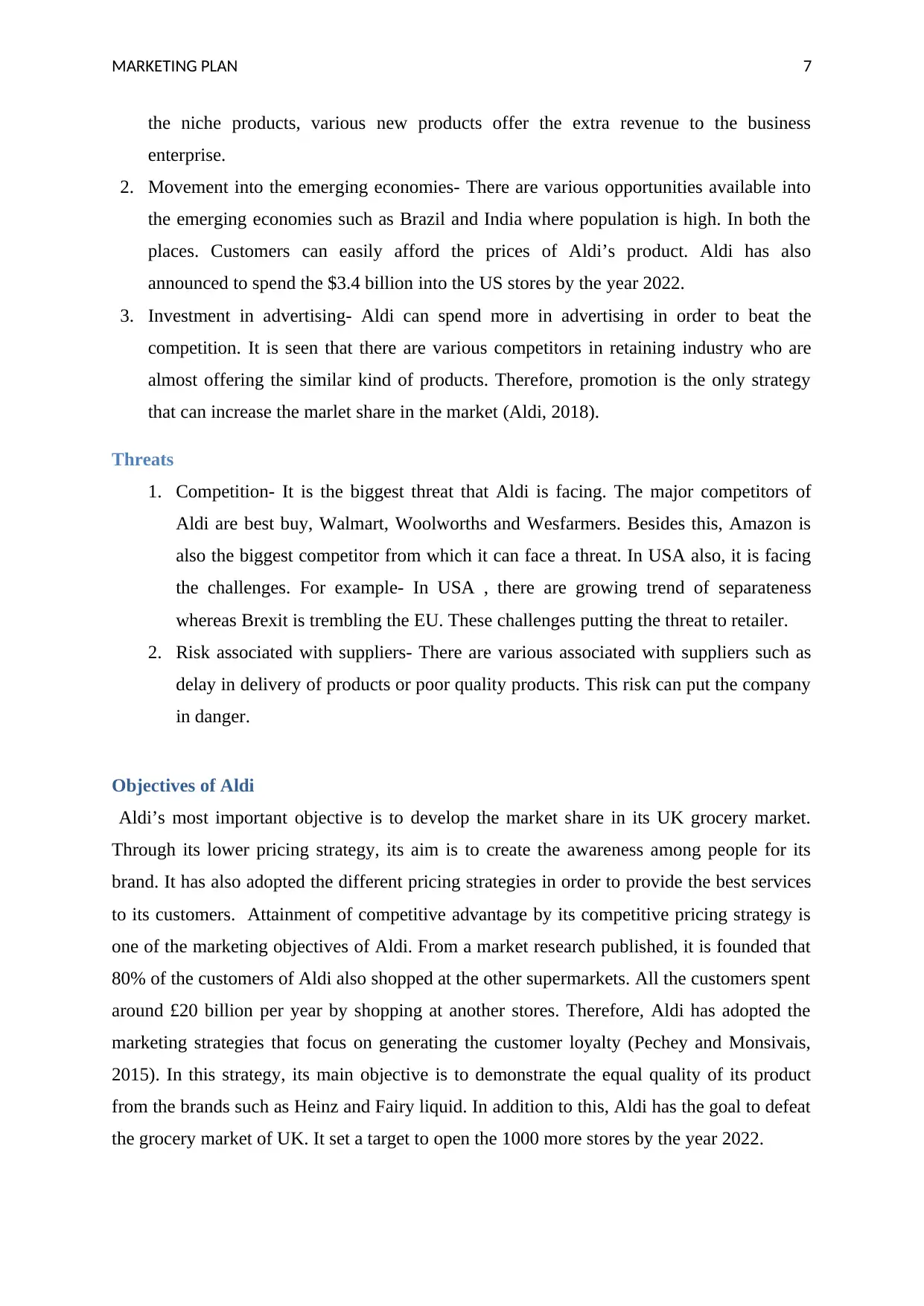
MARKETING PLAN 7
the niche products, various new products offer the extra revenue to the business
enterprise.
2. Movement into the emerging economies- There are various opportunities available into
the emerging economies such as Brazil and India where population is high. In both the
places. Customers can easily afford the prices of Aldi’s product. Aldi has also
announced to spend the $3.4 billion into the US stores by the year 2022.
3. Investment in advertising- Aldi can spend more in advertising in order to beat the
competition. It is seen that there are various competitors in retaining industry who are
almost offering the similar kind of products. Therefore, promotion is the only strategy
that can increase the marlet share in the market (Aldi, 2018).
Threats
1. Competition- It is the biggest threat that Aldi is facing. The major competitors of
Aldi are best buy, Walmart, Woolworths and Wesfarmers. Besides this, Amazon is
also the biggest competitor from which it can face a threat. In USA also, it is facing
the challenges. For example- In USA , there are growing trend of separateness
whereas Brexit is trembling the EU. These challenges putting the threat to retailer.
2. Risk associated with suppliers- There are various associated with suppliers such as
delay in delivery of products or poor quality products. This risk can put the company
in danger.
Objectives of Aldi
Aldi’s most important objective is to develop the market share in its UK grocery market.
Through its lower pricing strategy, its aim is to create the awareness among people for its
brand. It has also adopted the different pricing strategies in order to provide the best services
to its customers. Attainment of competitive advantage by its competitive pricing strategy is
one of the marketing objectives of Aldi. From a market research published, it is founded that
80% of the customers of Aldi also shopped at the other supermarkets. All the customers spent
around £20 billion per year by shopping at another stores. Therefore, Aldi has adopted the
marketing strategies that focus on generating the customer loyalty (Pechey and Monsivais,
2015). In this strategy, its main objective is to demonstrate the equal quality of its product
from the brands such as Heinz and Fairy liquid. In addition to this, Aldi has the goal to defeat
the grocery market of UK. It set a target to open the 1000 more stores by the year 2022.
the niche products, various new products offer the extra revenue to the business
enterprise.
2. Movement into the emerging economies- There are various opportunities available into
the emerging economies such as Brazil and India where population is high. In both the
places. Customers can easily afford the prices of Aldi’s product. Aldi has also
announced to spend the $3.4 billion into the US stores by the year 2022.
3. Investment in advertising- Aldi can spend more in advertising in order to beat the
competition. It is seen that there are various competitors in retaining industry who are
almost offering the similar kind of products. Therefore, promotion is the only strategy
that can increase the marlet share in the market (Aldi, 2018).
Threats
1. Competition- It is the biggest threat that Aldi is facing. The major competitors of
Aldi are best buy, Walmart, Woolworths and Wesfarmers. Besides this, Amazon is
also the biggest competitor from which it can face a threat. In USA also, it is facing
the challenges. For example- In USA , there are growing trend of separateness
whereas Brexit is trembling the EU. These challenges putting the threat to retailer.
2. Risk associated with suppliers- There are various associated with suppliers such as
delay in delivery of products or poor quality products. This risk can put the company
in danger.
Objectives of Aldi
Aldi’s most important objective is to develop the market share in its UK grocery market.
Through its lower pricing strategy, its aim is to create the awareness among people for its
brand. It has also adopted the different pricing strategies in order to provide the best services
to its customers. Attainment of competitive advantage by its competitive pricing strategy is
one of the marketing objectives of Aldi. From a market research published, it is founded that
80% of the customers of Aldi also shopped at the other supermarkets. All the customers spent
around £20 billion per year by shopping at another stores. Therefore, Aldi has adopted the
marketing strategies that focus on generating the customer loyalty (Pechey and Monsivais,
2015). In this strategy, its main objective is to demonstrate the equal quality of its product
from the brands such as Heinz and Fairy liquid. In addition to this, Aldi has the goal to defeat
the grocery market of UK. It set a target to open the 1000 more stores by the year 2022.
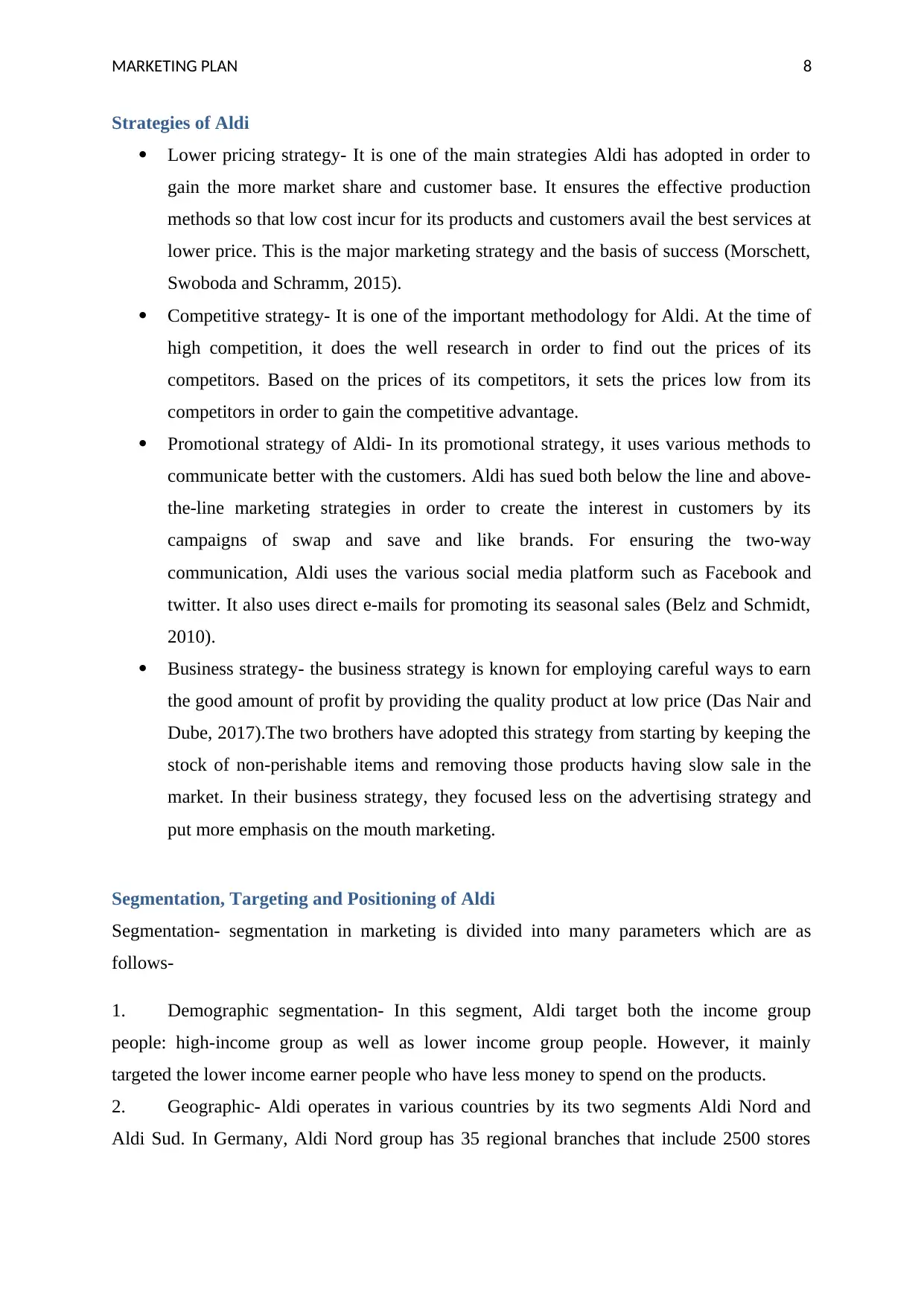
MARKETING PLAN 8
Strategies of Aldi
Lower pricing strategy- It is one of the main strategies Aldi has adopted in order to
gain the more market share and customer base. It ensures the effective production
methods so that low cost incur for its products and customers avail the best services at
lower price. This is the major marketing strategy and the basis of success (Morschett,
Swoboda and Schramm, 2015).
Competitive strategy- It is one of the important methodology for Aldi. At the time of
high competition, it does the well research in order to find out the prices of its
competitors. Based on the prices of its competitors, it sets the prices low from its
competitors in order to gain the competitive advantage.
Promotional strategy of Aldi- In its promotional strategy, it uses various methods to
communicate better with the customers. Aldi has sued both below the line and above-
the-line marketing strategies in order to create the interest in customers by its
campaigns of swap and save and like brands. For ensuring the two-way
communication, Aldi uses the various social media platform such as Facebook and
twitter. It also uses direct e-mails for promoting its seasonal sales (Belz and Schmidt,
2010).
Business strategy- the business strategy is known for employing careful ways to earn
the good amount of profit by providing the quality product at low price (Das Nair and
Dube, 2017).The two brothers have adopted this strategy from starting by keeping the
stock of non-perishable items and removing those products having slow sale in the
market. In their business strategy, they focused less on the advertising strategy and
put more emphasis on the mouth marketing.
Segmentation, Targeting and Positioning of Aldi
Segmentation- segmentation in marketing is divided into many parameters which are as
follows-
1. Demographic segmentation- In this segment, Aldi target both the income group
people: high-income group as well as lower income group people. However, it mainly
targeted the lower income earner people who have less money to spend on the products.
2. Geographic- Aldi operates in various countries by its two segments Aldi Nord and
Aldi Sud. In Germany, Aldi Nord group has 35 regional branches that include 2500 stores
Strategies of Aldi
Lower pricing strategy- It is one of the main strategies Aldi has adopted in order to
gain the more market share and customer base. It ensures the effective production
methods so that low cost incur for its products and customers avail the best services at
lower price. This is the major marketing strategy and the basis of success (Morschett,
Swoboda and Schramm, 2015).
Competitive strategy- It is one of the important methodology for Aldi. At the time of
high competition, it does the well research in order to find out the prices of its
competitors. Based on the prices of its competitors, it sets the prices low from its
competitors in order to gain the competitive advantage.
Promotional strategy of Aldi- In its promotional strategy, it uses various methods to
communicate better with the customers. Aldi has sued both below the line and above-
the-line marketing strategies in order to create the interest in customers by its
campaigns of swap and save and like brands. For ensuring the two-way
communication, Aldi uses the various social media platform such as Facebook and
twitter. It also uses direct e-mails for promoting its seasonal sales (Belz and Schmidt,
2010).
Business strategy- the business strategy is known for employing careful ways to earn
the good amount of profit by providing the quality product at low price (Das Nair and
Dube, 2017).The two brothers have adopted this strategy from starting by keeping the
stock of non-perishable items and removing those products having slow sale in the
market. In their business strategy, they focused less on the advertising strategy and
put more emphasis on the mouth marketing.
Segmentation, Targeting and Positioning of Aldi
Segmentation- segmentation in marketing is divided into many parameters which are as
follows-
1. Demographic segmentation- In this segment, Aldi target both the income group
people: high-income group as well as lower income group people. However, it mainly
targeted the lower income earner people who have less money to spend on the products.
2. Geographic- Aldi operates in various countries by its two segments Aldi Nord and
Aldi Sud. In Germany, Aldi Nord group has 35 regional branches that include 2500 stores
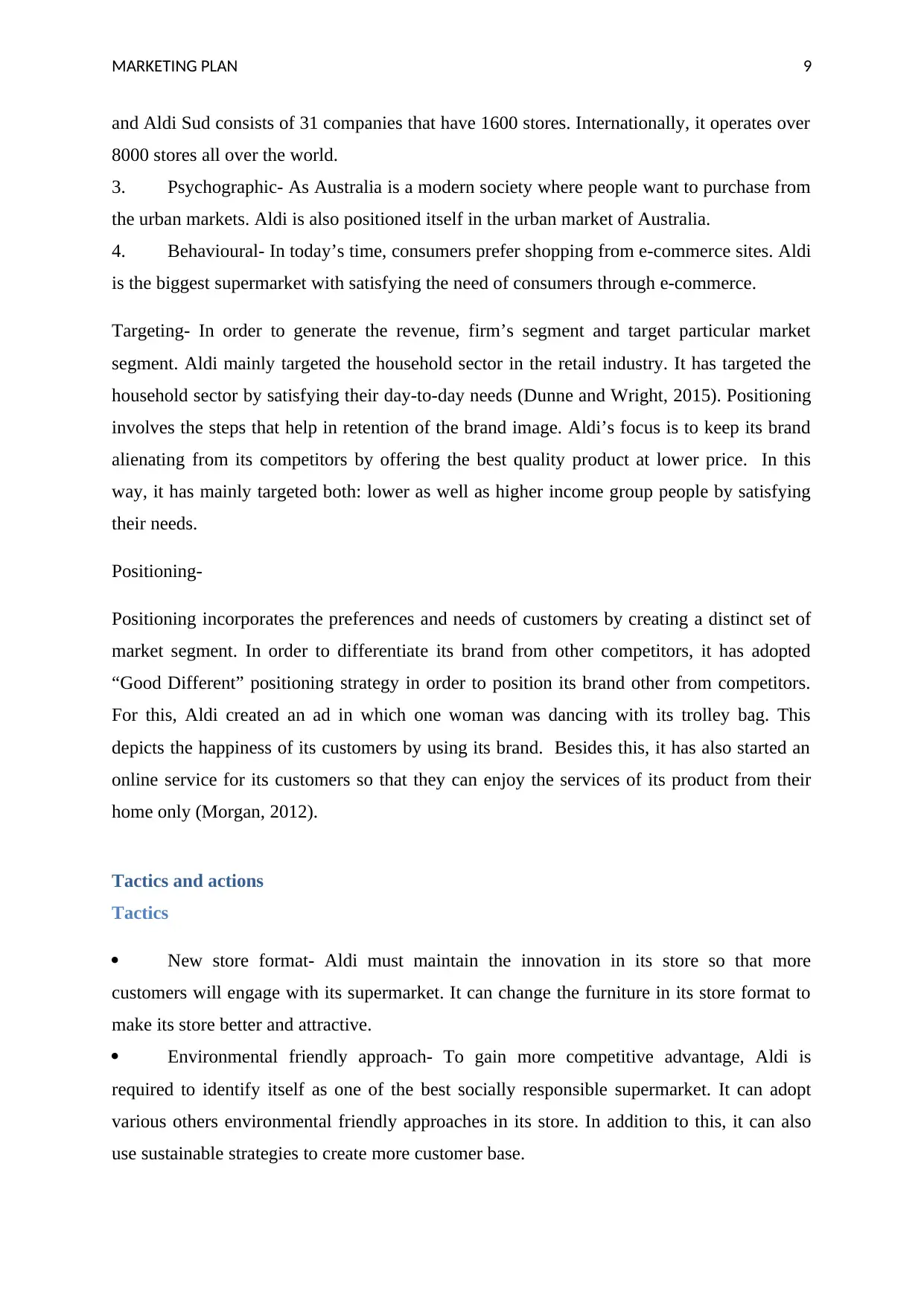
MARKETING PLAN 9
and Aldi Sud consists of 31 companies that have 1600 stores. Internationally, it operates over
8000 stores all over the world.
3. Psychographic- As Australia is a modern society where people want to purchase from
the urban markets. Aldi is also positioned itself in the urban market of Australia.
4. Behavioural- In today’s time, consumers prefer shopping from e-commerce sites. Aldi
is the biggest supermarket with satisfying the need of consumers through e-commerce.
Targeting- In order to generate the revenue, firm’s segment and target particular market
segment. Aldi mainly targeted the household sector in the retail industry. It has targeted the
household sector by satisfying their day-to-day needs (Dunne and Wright, 2015). Positioning
involves the steps that help in retention of the brand image. Aldi’s focus is to keep its brand
alienating from its competitors by offering the best quality product at lower price. In this
way, it has mainly targeted both: lower as well as higher income group people by satisfying
their needs.
Positioning-
Positioning incorporates the preferences and needs of customers by creating a distinct set of
market segment. In order to differentiate its brand from other competitors, it has adopted
“Good Different” positioning strategy in order to position its brand other from competitors.
For this, Aldi created an ad in which one woman was dancing with its trolley bag. This
depicts the happiness of its customers by using its brand. Besides this, it has also started an
online service for its customers so that they can enjoy the services of its product from their
home only (Morgan, 2012).
Tactics and actions
Tactics
New store format- Aldi must maintain the innovation in its store so that more
customers will engage with its supermarket. It can change the furniture in its store format to
make its store better and attractive.
Environmental friendly approach- To gain more competitive advantage, Aldi is
required to identify itself as one of the best socially responsible supermarket. It can adopt
various others environmental friendly approaches in its store. In addition to this, it can also
use sustainable strategies to create more customer base.
and Aldi Sud consists of 31 companies that have 1600 stores. Internationally, it operates over
8000 stores all over the world.
3. Psychographic- As Australia is a modern society where people want to purchase from
the urban markets. Aldi is also positioned itself in the urban market of Australia.
4. Behavioural- In today’s time, consumers prefer shopping from e-commerce sites. Aldi
is the biggest supermarket with satisfying the need of consumers through e-commerce.
Targeting- In order to generate the revenue, firm’s segment and target particular market
segment. Aldi mainly targeted the household sector in the retail industry. It has targeted the
household sector by satisfying their day-to-day needs (Dunne and Wright, 2015). Positioning
involves the steps that help in retention of the brand image. Aldi’s focus is to keep its brand
alienating from its competitors by offering the best quality product at lower price. In this
way, it has mainly targeted both: lower as well as higher income group people by satisfying
their needs.
Positioning-
Positioning incorporates the preferences and needs of customers by creating a distinct set of
market segment. In order to differentiate its brand from other competitors, it has adopted
“Good Different” positioning strategy in order to position its brand other from competitors.
For this, Aldi created an ad in which one woman was dancing with its trolley bag. This
depicts the happiness of its customers by using its brand. Besides this, it has also started an
online service for its customers so that they can enjoy the services of its product from their
home only (Morgan, 2012).
Tactics and actions
Tactics
New store format- Aldi must maintain the innovation in its store so that more
customers will engage with its supermarket. It can change the furniture in its store format to
make its store better and attractive.
Environmental friendly approach- To gain more competitive advantage, Aldi is
required to identify itself as one of the best socially responsible supermarket. It can adopt
various others environmental friendly approaches in its store. In addition to this, it can also
use sustainable strategies to create more customer base.
Secure Best Marks with AI Grader
Need help grading? Try our AI Grader for instant feedback on your assignments.
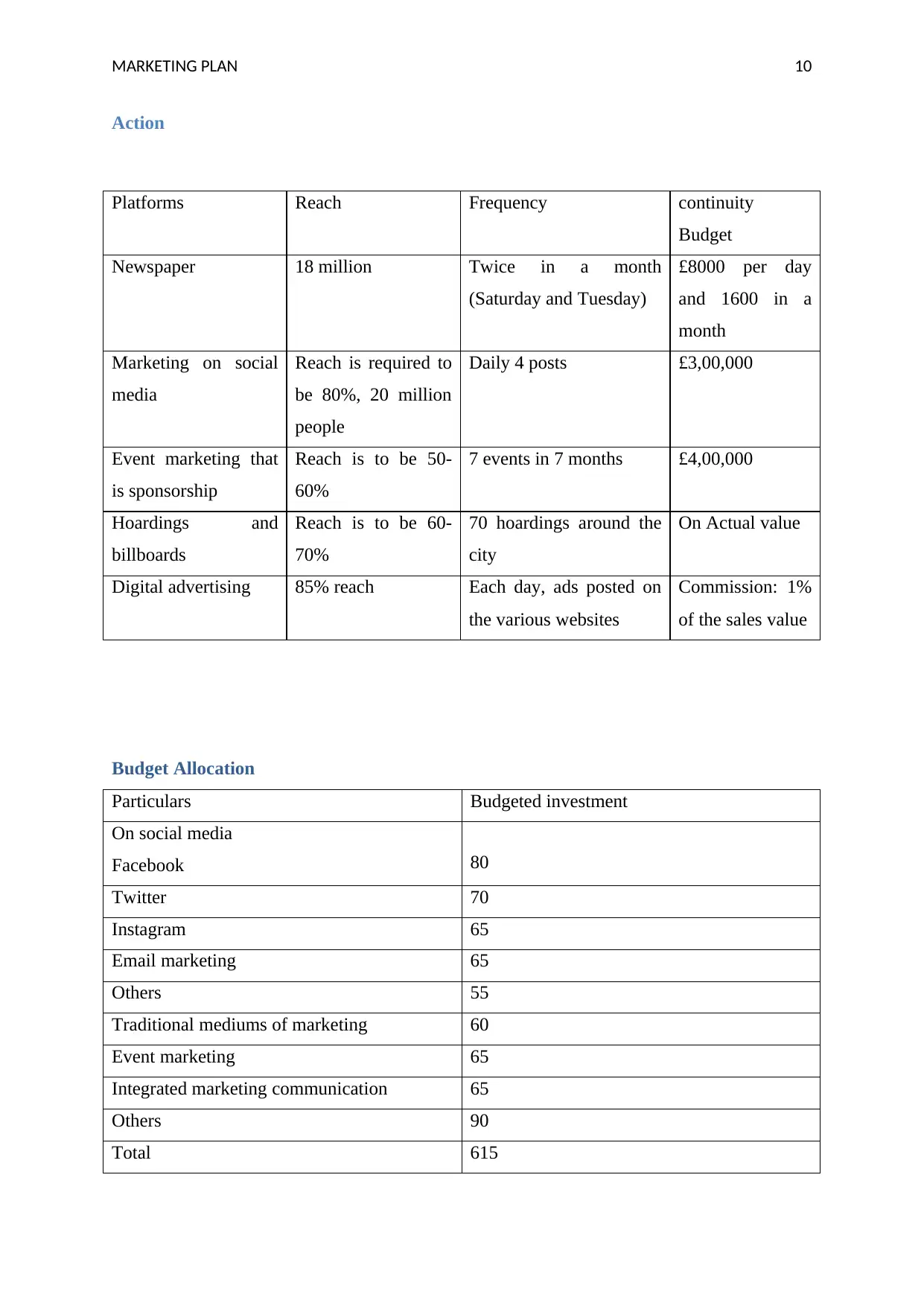
MARKETING PLAN 10
Action
Platforms Reach Frequency continuity
Budget
Newspaper 18 million Twice in a month
(Saturday and Tuesday)
£8000 per day
and 1600 in a
month
Marketing on social
media
Reach is required to
be 80%, 20 million
people
Daily 4 posts £3,00,000
Event marketing that
is sponsorship
Reach is to be 50-
60%
7 events in 7 months £4,00,000
Hoardings and
billboards
Reach is to be 60-
70%
70 hoardings around the
city
On Actual value
Digital advertising 85% reach Each day, ads posted on
the various websites
Commission: 1%
of the sales value
Budget Allocation
Particulars Budgeted investment
On social media
Facebook 80
Twitter 70
Instagram 65
Email marketing 65
Others 55
Traditional mediums of marketing 60
Event marketing 65
Integrated marketing communication 65
Others 90
Total 615
Action
Platforms Reach Frequency continuity
Budget
Newspaper 18 million Twice in a month
(Saturday and Tuesday)
£8000 per day
and 1600 in a
month
Marketing on social
media
Reach is required to
be 80%, 20 million
people
Daily 4 posts £3,00,000
Event marketing that
is sponsorship
Reach is to be 50-
60%
7 events in 7 months £4,00,000
Hoardings and
billboards
Reach is to be 60-
70%
70 hoardings around the
city
On Actual value
Digital advertising 85% reach Each day, ads posted on
the various websites
Commission: 1%
of the sales value
Budget Allocation
Particulars Budgeted investment
On social media
Facebook 80
Twitter 70
Instagram 65
Email marketing 65
Others 55
Traditional mediums of marketing 60
Event marketing 65
Integrated marketing communication 65
Others 90
Total 615
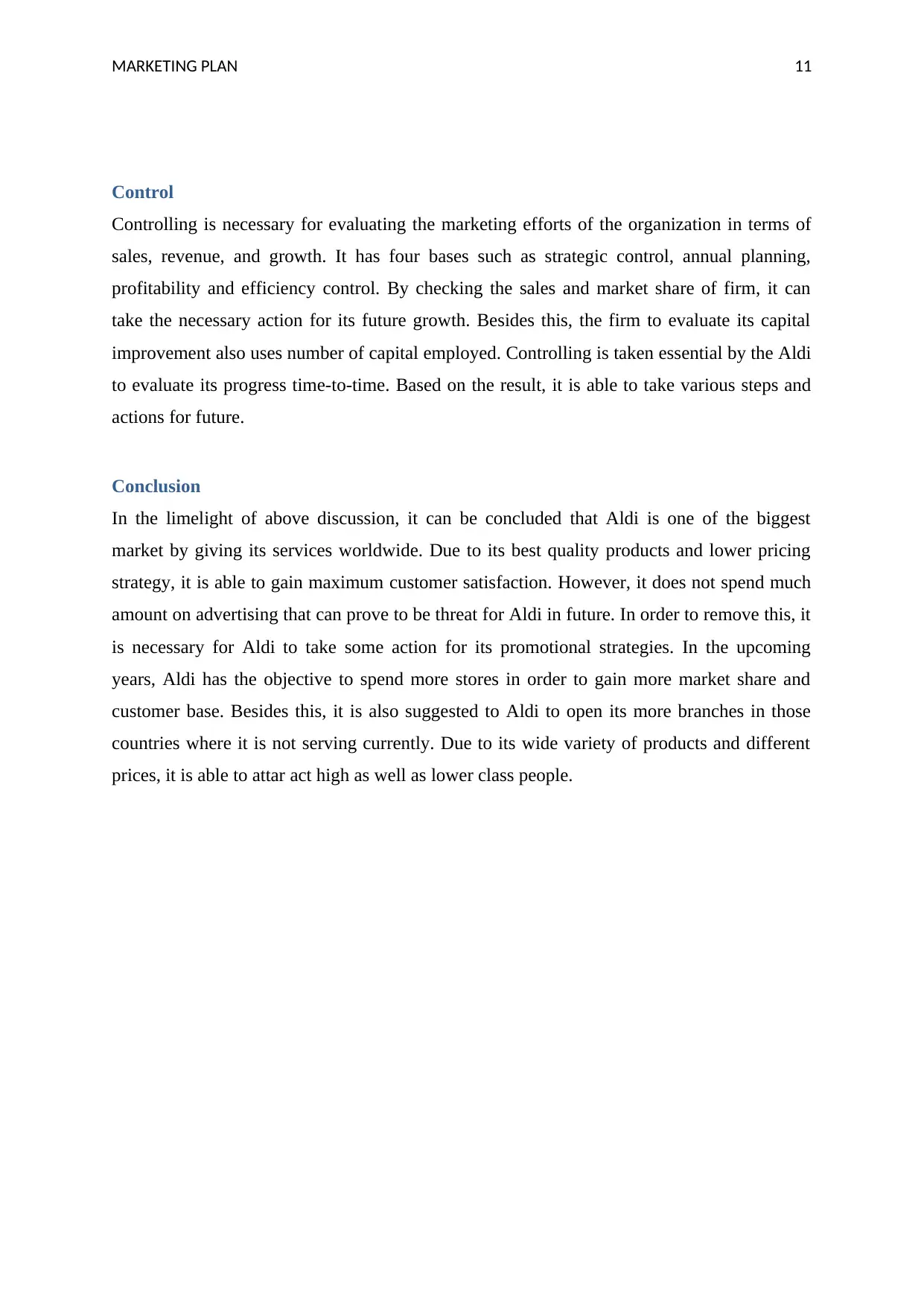
MARKETING PLAN 11
Control
Controlling is necessary for evaluating the marketing efforts of the organization in terms of
sales, revenue, and growth. It has four bases such as strategic control, annual planning,
profitability and efficiency control. By checking the sales and market share of firm, it can
take the necessary action for its future growth. Besides this, the firm to evaluate its capital
improvement also uses number of capital employed. Controlling is taken essential by the Aldi
to evaluate its progress time-to-time. Based on the result, it is able to take various steps and
actions for future.
Conclusion
In the limelight of above discussion, it can be concluded that Aldi is one of the biggest
market by giving its services worldwide. Due to its best quality products and lower pricing
strategy, it is able to gain maximum customer satisfaction. However, it does not spend much
amount on advertising that can prove to be threat for Aldi in future. In order to remove this, it
is necessary for Aldi to take some action for its promotional strategies. In the upcoming
years, Aldi has the objective to spend more stores in order to gain more market share and
customer base. Besides this, it is also suggested to Aldi to open its more branches in those
countries where it is not serving currently. Due to its wide variety of products and different
prices, it is able to attar act high as well as lower class people.
Control
Controlling is necessary for evaluating the marketing efforts of the organization in terms of
sales, revenue, and growth. It has four bases such as strategic control, annual planning,
profitability and efficiency control. By checking the sales and market share of firm, it can
take the necessary action for its future growth. Besides this, the firm to evaluate its capital
improvement also uses number of capital employed. Controlling is taken essential by the Aldi
to evaluate its progress time-to-time. Based on the result, it is able to take various steps and
actions for future.
Conclusion
In the limelight of above discussion, it can be concluded that Aldi is one of the biggest
market by giving its services worldwide. Due to its best quality products and lower pricing
strategy, it is able to gain maximum customer satisfaction. However, it does not spend much
amount on advertising that can prove to be threat for Aldi in future. In order to remove this, it
is necessary for Aldi to take some action for its promotional strategies. In the upcoming
years, Aldi has the objective to spend more stores in order to gain more market share and
customer base. Besides this, it is also suggested to Aldi to open its more branches in those
countries where it is not serving currently. Due to its wide variety of products and different
prices, it is able to attar act high as well as lower class people.

MARKETING PLAN 12
References
Aldi. (2018) About us. [online] Available from: https://corporate.aldi.com.au/en/about-aldi/
[accessed 26/11/18].
Belz, F.M. and Schmidt‐Riediger, B. (2010) Marketing strategies in the age of sustainable
development: evidence from the food industry. Business Strategy and the
Environment, 19(7), pp.401-416.
Berman, B. (2015) How to compete effectively against low-cost competitors. Business
Horizons, 58(1), pp.87-97.
Business case studies. (2018) Creating value through the marketing mix an Aldi case study.
[online] Available from: http://businesscasestudies.co.uk/aldi/creating-value-through-the-
marketing-mix/the-marketing-mix.html [accessed 26/11/18].
Cavallo, A. (2017) Are online and offline prices similar? evidence from large multi-channel
retailers. American Economic Review, 107(1), pp.283-303.
Chatterjee, S. (2017) Two efficiency-driven networks on a collision course: ALDI’s
innovative grocery business model vs Walmart. Strategy & Leadership, 45(5), pp.18-25.
Das Nair, R. and Dube, S. (2017 ) Growth and strategies of large, lead firms-Supermarkets.
United Kingdom: Routledge.
Dunne, M. and Wright, A. (2015) Local and artisan food: A case for supermarket space?.
11th Annual Tourism and Hospitality Research in Ireland Conference (THRIC).
Grünig, R. and Morschett, D. (2017) Determining the Differentiation-Standardization Level
of the Market Offer. In Developing International Strategies (pp. 185-195). Springer, Berlin,
Heidelberg.
Inderst, R. and Obradovits, M. (2015) Too Much Attention on Low Prices? Loss Leading in a
Model of Sales with Salient Thinkers. United Kingdom: Routledge.
Kincaid, E. (2018) Aldi beats Walmart on price online, study finds. [online] Available from:
https://www.grocerydive.com/news/grocery--aldi-beats-walmart-on-price-online-study-
finds/534309/ [accessed 25/11/18].
References
Aldi. (2018) About us. [online] Available from: https://corporate.aldi.com.au/en/about-aldi/
[accessed 26/11/18].
Belz, F.M. and Schmidt‐Riediger, B. (2010) Marketing strategies in the age of sustainable
development: evidence from the food industry. Business Strategy and the
Environment, 19(7), pp.401-416.
Berman, B. (2015) How to compete effectively against low-cost competitors. Business
Horizons, 58(1), pp.87-97.
Business case studies. (2018) Creating value through the marketing mix an Aldi case study.
[online] Available from: http://businesscasestudies.co.uk/aldi/creating-value-through-the-
marketing-mix/the-marketing-mix.html [accessed 26/11/18].
Cavallo, A. (2017) Are online and offline prices similar? evidence from large multi-channel
retailers. American Economic Review, 107(1), pp.283-303.
Chatterjee, S. (2017) Two efficiency-driven networks on a collision course: ALDI’s
innovative grocery business model vs Walmart. Strategy & Leadership, 45(5), pp.18-25.
Das Nair, R. and Dube, S. (2017 ) Growth and strategies of large, lead firms-Supermarkets.
United Kingdom: Routledge.
Dunne, M. and Wright, A. (2015) Local and artisan food: A case for supermarket space?.
11th Annual Tourism and Hospitality Research in Ireland Conference (THRIC).
Grünig, R. and Morschett, D. (2017) Determining the Differentiation-Standardization Level
of the Market Offer. In Developing International Strategies (pp. 185-195). Springer, Berlin,
Heidelberg.
Inderst, R. and Obradovits, M. (2015) Too Much Attention on Low Prices? Loss Leading in a
Model of Sales with Salient Thinkers. United Kingdom: Routledge.
Kincaid, E. (2018) Aldi beats Walmart on price online, study finds. [online] Available from:
https://www.grocerydive.com/news/grocery--aldi-beats-walmart-on-price-online-study-
finds/534309/ [accessed 25/11/18].
Paraphrase This Document
Need a fresh take? Get an instant paraphrase of this document with our AI Paraphraser

MARKETING PLAN 13
Methner, N., Hamann, R. and Nilsson, W. (2015) The Evolution of a Sustainability Leader:
The Development of Strategic and Boundary Spanning Organizational Innovation
Capabilities in Woolworths. In The Business of Social and Environmental Innovation (pp. 87-
104). Springer, Cham.
Morgan, N.A. (2012) Marketing and business performance. Journal of the Academy of
Marketing Science, 40(1), pp.102-119.
Morschett, D., Swoboda, B. and Schramm-Klein, H. (2015) Competitive strategies in
retailing—an investigation of the applicability of Porter's framework for food
retailers. Journal of Retailing and Consumer Services, 13(4), pp.275-287.
Mortimer, G. (2016) ALDI gives suppliers, as well as shoppers, greater choice: Retail
expert. Journal of the Home Economics Institute of Australia, 23(2), p.39.
Pechey, R. and Monsivais, P. (2015) Supermarket choice, shopping behavior, socioeconomic
status, and food purchases. American journal of preventive medicine, 49(6), pp.868-877.
Stanton, J.L. (2018) A brief history of food retail. British Food Journal, 120(1), pp.172-180.
van Rompay, T.J., Deterink, F. and Fenko, A. (2016) Healthy package, healthy product?
Effects of packaging design as a function of purchase setting. Food quality and
preference, 53, pp.84-89.
Voigt, K.I., Buliga, O. and Michl, K. (2017) Striving for Customer Benefit: The Case of Aldi.
In Business Model Pioneers (pp. 11-24). Springer, Cham.
Methner, N., Hamann, R. and Nilsson, W. (2015) The Evolution of a Sustainability Leader:
The Development of Strategic and Boundary Spanning Organizational Innovation
Capabilities in Woolworths. In The Business of Social and Environmental Innovation (pp. 87-
104). Springer, Cham.
Morgan, N.A. (2012) Marketing and business performance. Journal of the Academy of
Marketing Science, 40(1), pp.102-119.
Morschett, D., Swoboda, B. and Schramm-Klein, H. (2015) Competitive strategies in
retailing—an investigation of the applicability of Porter's framework for food
retailers. Journal of Retailing and Consumer Services, 13(4), pp.275-287.
Mortimer, G. (2016) ALDI gives suppliers, as well as shoppers, greater choice: Retail
expert. Journal of the Home Economics Institute of Australia, 23(2), p.39.
Pechey, R. and Monsivais, P. (2015) Supermarket choice, shopping behavior, socioeconomic
status, and food purchases. American journal of preventive medicine, 49(6), pp.868-877.
Stanton, J.L. (2018) A brief history of food retail. British Food Journal, 120(1), pp.172-180.
van Rompay, T.J., Deterink, F. and Fenko, A. (2016) Healthy package, healthy product?
Effects of packaging design as a function of purchase setting. Food quality and
preference, 53, pp.84-89.
Voigt, K.I., Buliga, O. and Michl, K. (2017) Striving for Customer Benefit: The Case of Aldi.
In Business Model Pioneers (pp. 11-24). Springer, Cham.
1 out of 14
Related Documents
Your All-in-One AI-Powered Toolkit for Academic Success.
+13062052269
info@desklib.com
Available 24*7 on WhatsApp / Email
![[object Object]](/_next/static/media/star-bottom.7253800d.svg)
Unlock your academic potential
© 2024 | Zucol Services PVT LTD | All rights reserved.





